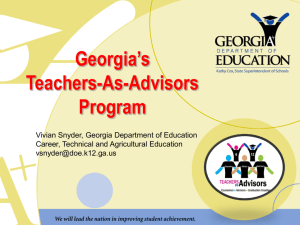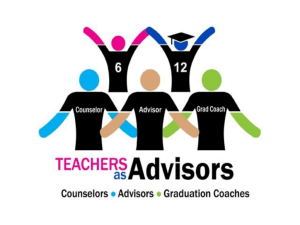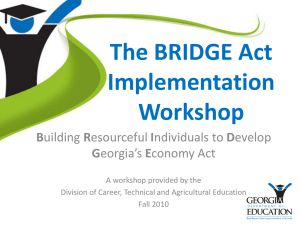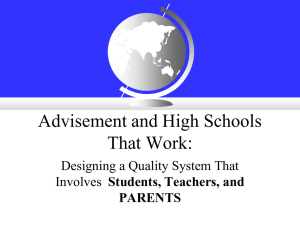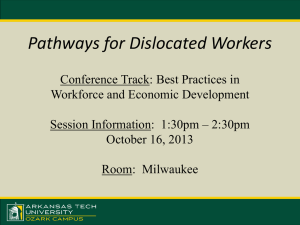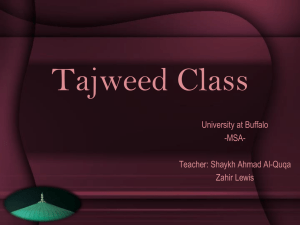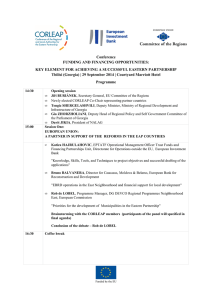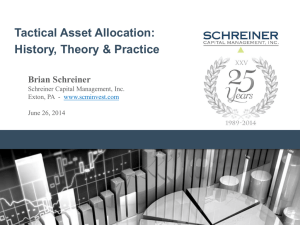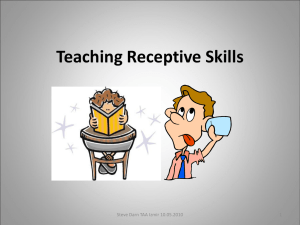Teachers-As-Advisors Orientation and Awareness Presentation
advertisement
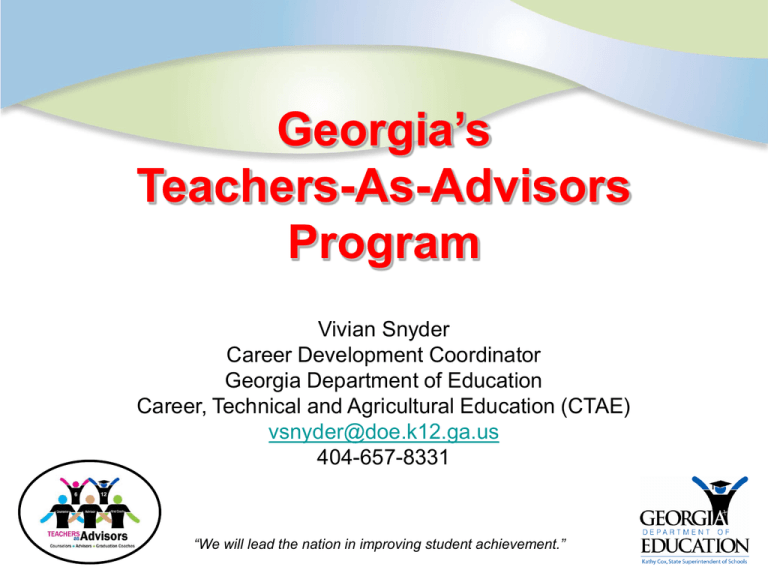
Click to edit Master title style Georgia’s Teachers-As-Advisors Program Vivian Snyder Career Development Coordinator Georgia Department of Education Career, Technical and Agricultural Education (CTAE) vsnyder@doe.k12.ga.us 404-657-8331 “We will lead the nation in improving student achievement.” It’s a question of: How many opportunities do ALL Georgia students have to explore the world of work? To understand the connection between school work and their future career? To assess their individual interests and aptitudes? To assess their work values and preferences? To assess their individual learning, collaboration, and problem-solving styles? To develop a plan of action to reach their educational and career goals? The New 3 R’s Rigor Relevance Relationships What is TAA? A systemic, systematic method of delivery wherein an entire student population (grades 6-12) is assigned, in small groups, to a trained, caring adult advisor who both advocates for his or her advisees and facilitates sessions focused on: 1. Career Management: Awareness, Exploration, and Planning 2. Academic Achievement, Educational Attainment and Lifelong Learning: Academic Development 3. Life Skills: Personal and Social Development The TAA 10-Step Model 1. Establishing Need and Gaining Awareness of Data 2. The Educational and Career Planning Process 3. Articulating a Statement of Purpose 4. Strategic Planning for Parent/Family Involvement 5. Achieving Consensus on Organization and Logistics 6. Designing Framework-Based Content for Delivery 7. Understanding and Fully Utilizing Assessment Results 8. Determining the Level of Leader Involvement and Support 9. Professional Learning and Ongoing Support 10. Assessing the Effectiveness of a TAA Program Training Goals • Gain awareness of the 10-Step Model for creating, implementing, enhancing, and/or evaluating a systemic and systematic TAA program that serves ALL students within a local educational agency (LEA) in grades 6-12 • Create a vision and purpose for advisement that is based on theory, research, and field expertise Training Goals • Address issues of school processes and structures that support and/or diminish the effectiveness of TAA • Explore the Georgia TAA framework and plan activities to use during advisement sessions • Investigate the utilization of assessment mechanisms • Learn how to build capacity and create conditions for TAA long-term sustainability State TAA Training Tools • Video modules that will demonstrate the process for development and implementation • Accompanying, coordinated materials and resources to assist the advisement focus team • Online repository of lessons through GeorgiaStandards.Org (GSO) • Assessment resources/GAcollege411.org GSO: Online Resources Link GSO: Online Resources Link GSO: Online Resources Link GSO: Online Resources Link GSO: Online Resources Link Georgia Teachers-As-Advisors Framework GSO: Video Modules Establishing Need and Gaining Awareness of Data “Since we live in an age of innovation, a practical education must prepare a man for work that does not yet exist and cannot be clearly defined.” Peter Drucker Facing the Brutal Facts • • • • • • Georgia high school graduation rate? Under 80% 9th grade retention rate? Too high, overrepresentation of specific groups of students Postsecondary matriculation? Poor, sometimes less than 20% Labor market needs? Skills shortage, labor shortage A 2001 study by the National Association of Manufacturers revealed that 78% of work force representatives believe public schools are failing to prepare students for the workplace. This represents little change from similar 1991 and 1997 surveys administered by the agency, despite a decade of various education movements. Parental involvement? Very little, low level of authenticity Anonymity of students? Yes, we have students we don’t really know. Education and Training Pays Georgia Workforce 2016 Beyond the Horizon. Workforce Information & Analysis Division, p 28. Face the facts! Ask yourselves… • What are the high-skill, high-demand, high-wage jobs identified for your county or region by the Georgia Department of Labor (DOL), the Governor’s Office of Workforce Development, etc.? • What are the programs of study offered at your local high schools? • Are the two aligned? Will they lead your students to high-skill, high-demand, and high-wage careers? The NEED for change… • The skills and knowledge required in the workplace are no longer very different from those needed for success in “college”. (Somerville and Yi, 2002) • 12 of the 20 fastest growing occupations, an associate degree or higher is the most significant level of postsecondary education or training. (Tomorrow’s Jobs http://www.bls.gov/oco/oco2003.htm) • One study estimated the cost of remedial training in reading, writing and mathematics to a single state’s employers at nearly $40 million a year. (The American Diploma Project: Ready or Not; Creating a High School Diploma that Counts, 2006) Student Preparation • Only 32% of students who enter 9th grade and graduate four years later have mastered basic literacy skills and have completed the coursework necessary to succeed in a four-year college. (Achieve, Inc., The Expectations Gap: A 50-State Review of High School Graduation Requirements, 2004) • Consistent with national data, absenteeism is the most common indicator of overall student engagement and a significant predictor of dropping out. (The Silent Epidemic: Perspectives of High School Dropouts, Gates Foundation, 2006) Student Coursework • Research shows that the ability to comprehend complex texts is the clearest differentiator between students who are ready for college-level reading and those who are not. (College Readiness: 2005 State Report, ACT) • 81% of (dropout) survey respondents said that if schools provided opportunities for real-world learning (internships, service learning projects, and other opportunities), it would have improved the students’ chances of graduating from high school. (The Silent Epidemic: Perspectives of High School Dropouts, Gates Foundation, 2006. ) Expectations • Studies show that the expectations that teachers have for their students has an effect both on student performance and whether they drop out of school. (The Silent Epidemic: Perspectives of High School Dropouts, Gates Foundation, 2006.) • 72% of high school graduates who did not go to college responded that knowing what they know today about the expectations of college and the work world, they would have taken more challenging courses in at least one area. (Achieve, Inc., 2005, Rising to the Challenge: Are High School Graduates Prepared for College and Work?) An Essential Difference Counseling Advisement The help that some students need to overcome personal and social problems that interfere with learning. The help that ALL students need from parents, teachers, counselors and others to assist with educational and career development and planning. Resources for Establishing Need and Gaining Awareness of Data • Georgia Department of Labor/Georgia Labor Market Explorer http://www.dol.state.ga.us http://explorer.dol.state.ga.us • Occupational Supply and Demand System http://test.occsupplydemand.net/OSD_Main.aspx • One Georgia Authority http://www.onegeorgia.org/coi.html • Partnership for 21st Century Skills http://www.21stcenturyskills.org/ The Educational and Career Planning Process Basic Assumptions • ALL educators are career developers. “Teachers make all professions possible” Annie Belott • ALL students are expected to work, therefore, ALL students need career development. “The future of work is ‘learning a living.’ ” Marshall McLuhan • Parents can be the greatest influence in a student’s career decision-making process. Therefore, parents need information also. Who Am I? GACollege411, including • Interest Profiler • Career Cluster Survey • Work Values Sorter • Transferable Skills • Career Keys • Basic Skills PSAT Armed Services Vocational Aptitude Battery(ASVAB) Where Am I Going? • Georgia Teachers-As-Advisors Framework and Activities • O*NET, Careerclusters.org; OOH; Career Voyages (USDOL and USDOE) • Career Centers - Knowledge, Resources, Materials, and Tools • Labor Market Information – DOL/Georgia Explorer • Work-Based Learning (MS and HS) • GACollege411 – Career Planning • Classroom Activities How Am I Going To Get There? • Electronic Portfolio System GAcollege411.com www.GAcollege411.org • Peach State Pathways http://www.gadoe.org/ci_cta.aspx?P ageReq=CICTAPlanningNew Articulating a Statement of Purpose Program Purpose: Specific purposes your advisory program be designed to meet: Program Purpose Priority Value - Essential, nonnegotiable - Important, but negotiable - Experimental and negotiable Addresses students’ needs in what ways? Reflects the needs of the community in what ways? - All students? - Subgroups? Finally, write a statement of purpose and create a framework for your advisory program. Refer to other parts of this document, GADOE resources, Breaking Ranks II, Breaking Ranks in the Middle and other potential resources. “Georgia will lead the nation in student achievement.” K. Cox Jefferson County School System Teachers-As-Advisors Statement of Purpose The mission of the Jefferson County School System Advisor-Advisee Program is to ensure high levels of student achievement through the following: • Providing a caring, trained adult advocate • Establishing regular communication and an effective link between home and school • Advising students about academic decisions and monitoring academic achievement • Creating, facilitating, and guiding movement toward a career concentration so that each child will be postsecondary ready • Facilitating seamless academic and social transitions across grades and schools for students and their families Strategic Planning for Parent/Family Involvement Strategic Planning for Parent/Family Involvement • How do we create parent and family involvement that is systemic, systematic, and authentic? • What are the “value-added” elements of parent and family involvement in the Teachers-As-Advisors process? Strategic Planning for Parent/Family Involvement Basic indicators for the relationship between advisor and family: • Friendly, helpful environment • Genuine concern • Communication, communication, communication • Viewing parents as partners • At the least an annual review of student progress in the spring of each year Achieving Consensus on Organization and Logistics People and Size • How many advisees will each advisor have? • Which adults in the school will serve as advisors? What characteristics should they possess? • If some teachers do not serve as advisors, what supportive roles can they take on? Will any advisories be co-facilitated? • By what criteria will the students be divided into advisory groups? • By what criteria will individual students be paired with advisors? • Will advisors and advisees be looped (paired for their tenure in the building)? What, if any, exceptions would there be to that rule? • What will be the specific roles and responsibilities of advisors? • How will parents be included and involved in the advisory process? • How or will business and community volunteers be included and involved in the advisory process? Effective Practices: People & Size • Consider one advisor to 12-18 student advisees (average) • Come to consensus who will serve as advisors? Certified staff only? • Co-facilitate advisories in working with students with disabilities (create two small advisee groups and pair two advisors (one reg. ed and one spec. ed); this allows for inclusion of SWDs, with the option of utilizing advisory time to, occasionally, review IEP progress). • Match advisors-advisees based on interests, advisor-strength/ student need(s), personalities, etc. – anything but the “alphabet” method! • “Loop” advisors-advisees for a student’s duration in the building- The longitudinal relationship and the knowledge it yields are the powers of TAA! • Utilize a rubric to define and assess roles and responsibilities of advisors. • Connect with parents through on-going communication, establishing the advisor as the central contact point at the school, and increased conferencing. • Business and community partners are an invaluable resource in advisement, especially in the career and workforce development components. Time and Space • How often will advisement sessions meet (daily, weekly, monthly, etc.)? • How long will advisement sessions be (brief check-ins, longer activity periods)? • Will there be time for individual meetings as well as group meetings? • How will this time fit into the master schedule? • Where will advisories meet? • How will advisories be able to personalize their space? • Will each advisory have its own space? Effective Practices: Time & Space • Hold a minimum of two advisory sessions per month; however, more frequent meetings of a shorter duration are equally as effective. • Look for informal ways to connect with advisee between advisory sessions (Ex.-look for a face-to-face connection with each advisee 2-3 times per week…perhaps simply saying “hello” in the hall or cafeteria). • Consider a blend of brief check-ins, longer activity periods; ideally, both types of sessions are needed. • Allow for meetings with individual students, as well as the regular small-group, advisory meetings. • Advisement is easily scheduled in middle and high schools. Consider the creation of a scheduled period that allows for extra-help and/or enrichment; advisement is an appropriate, additional use of that time. • Flexibility is a key element when considering meeting space for advisory groups… students just need a comfortable place! Student Involvement/Ownership • What role will students take in creating/overseeing the advisory program? • How can advisement in grades 6-12 serve as a vehicle for raising graduation rates? • How can advisement in grades 6-12 serve as a vehicle for raising student achievement? • How can advisement in grades 6-12 serve as a vehicle to facilitate more students pursuing postsecondary study? • How can students in the upper-grade advisements mentor students in the lower-grade advisories? Effective Practices: Student Involvement/Ownership • Create a TAA advisory committee made up of students to gain students’ perspectives on the total advisement program and its processes. • Give students (grades 6-12) a voice in considering the following: • – How can advisories serve as a vehicle for raising graduation rates? – How can advisories serve as a vehicle for raising the rigor of core academic studies and student achievement? – How can advisories serve as a vehicle for leading students to a focused area of study in high school? – How can advisories serve as a vehicle to facilitate more students pursuing postsecondary credit opportunities (during high school) and postsecondary study (after graduation)? Create structures for students in the upper-grade advisories to mentor students in the lower-grade advisories. Designing Framework-Based Content for Students Designing Framework-Based Content for Students Use the Georgia TAA Framework to gather materials and develop TAA sessions/activities • TAA Framework can be found at GeorgiaStandards.Org under “Resources” at https://www.georgiastandards.org/Resources/Pages/ Tools/Teachers-as-Advisors.aspx Understanding and Fully Utilizing Assessment Results Understanding and Fully Utilizing Assessment Results Draw from multiple assessment resources to gain a comprehensive look at each individual student (strengths, interests, aptitude, work values, and preferences). • State Assessments (CRCT, EOCT, GHSGT, etc.) • PSAT, SAT, etc. • GAcollege411 six Career-related Assessments • Armed Services Vocational Aptitude Battery (ASVAB) • Other interest, aptitude, and work-values and preferences assessments Determining the Level of Leader Involvement and Support Determining the Level of Leader Involvement and Support Who will champion Teachers-As-Advisors in your district or school? Responsibilities • Principal responsibilities • Advisor responsibilities • Counselor responsibilities • Advisee responsibilities Barriers and challenges and how to address them Professional Learning and Continued Support Professional Learning and Continued Support Develop a professional learning plan to include: • Informational sessions • Skill building sessions • Continued support − Regular feedback - What works! − Incentives - Help me! − Results data - Is this work paying off? Professional Learning and Continued Support • How do we create regularly scheduled time for advisors to meet with students (coordination with the academic calendar and time for training, curriculum development, sharing successes)? • In what types of configurations can advisors meet for training and support (clusters, teams, full faculty, pairs)? • How will we identify the types of training and support advisors need (academic advising, how to communicate with parents, listening skills, knowing when to refer advisees to others, etc.)? • How will the initial training be conducted and by whom? • What resources will advisors need? Will these resources be readily available? • What ongoing support will be provided after initial training? • How will advisors be observed and assessed? Effective Practices: Professional Learning and Continued Support • Because advisement is best implemented at the district level, form a district-level TAA focus team that is made up of school-level focus teams. A school-level focus team should be made up of (5-7 members): – the principal (or his/her administrative designee) – counselor(s) and/or graduation coach(es) – teachers who are skilled at building relationships with students – teachers who are knowledgeable of career development – teachers who may be skeptical of the value of advisement • Building leaders must protect time scheduled for advisement. • Consider holding sessions for TAA training and support during the school day (planning periods) and forming additional support structures (clusters, teams, pairs) for teacher-advisors. • Identify the types of training, resources, and support advisors need through information gathered from teacher-advisor surveys, student surveys, postadvisement reflections, and observation of advisory sessions. Assessing TAA Program Effectiveness Assessing the Effectiveness of a Teachers-As-Advisors Program • Data-driven outcomes (programmatic measures, advisor • effectiveness, student satisfaction, parent satisfaction, etc.) - What kinds of data will you collect? - How will you gather data to measure outcomes? Graduation; retention; behavioral referrals; # of students taking higher level courses; pathway selection; utilization of GACollege411;survey students, staff, and parents • Rubrics − How will you develop rubrics and hold each participant in the process accountable? Evaluating Your Teachers-As-Advisor Program ADVANCED PROFICIENT BASIC DEVELOPING (Majority of criteria checked in each section) (Minimum of 3 criteria checked in each section) (Minimum of 2 criteria checked in each section) (Must have at least 1 criterion checked in each section) 56-66 Points 41-55 Points 26 – 40 Points 11- 25 Points NOT YET ESTABLISHED (No criteria checked in one or more sections) 0-10 Points Advanced Your TAA program is well established. Continue to review and self-evaluate after every session and make required adjustments as needed to continue to help students be successful. Proficient Your TAA program has engaged the majority of your school’s staff, students and parents. The TAA activities are varied and supportive of students’ goals. Continue to challenge yourselves to find additional ways to provide students the opportunity to develop skills they need for future success. Basic Your TAA program is meeting the standard. Continue to meet on a regular basis with your advisory committee, encourage staff participation, and seek feedback from students and parents to help make progress in what you’re doing. Developing Your TAA program is in the development stage. You most likely have been working hard to develop a program in which everyone is actively involved. You feel frustration because not everyone views it as their job to assist students in planning for their future. Continue to seek administrative support, train staff on a regular basis and seek community assistance. Not Yet Established Seek assistance because your TAA program may need improvement or you have not worked to develop and implement a TAA program. Implementing TAA • Teachers-As-Advisors is BEST implemented at the DISTRICT level by a TEAM of professionals. In a very large district, this can be done by MS-HS feeder patterns. • The district-level TAA Focus Team should be made up of its school-level focus teams. A school-level focus team should be made up of (5-7 members): − The principal (or his/her administrative designee) − Counselor(s) and/or graduation coach(es) − One or more teachers who are skilled at building relationships with students − One or more teachers who are knowledgeable of career development − One or more teachers who may be skeptical of the value of advisement and have a need to be a part of the development Thank you for attending! Click to edit Master title style Georgia’s Teachers-As-Advisors Program Vivian Snyder Career Development Coordinator Georgia Department of Education Career, Technical and Agricultural Education (CTAE) vsnyder@doe.k12.ga.us 404-657-8331 “We will lead the nation in improving student achievement.”
